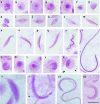Study of acrosome formation, interspecific and intraspecific, in the testicular lobes of some pentatomid species
- PMID: 20883131
- PMCID: PMC3016936
- DOI: 10.1673/031.010.13201
Study of acrosome formation, interspecific and intraspecific, in the testicular lobes of some pentatomid species
Abstract
The objective was to compare the formation of the acrosome in the testicular lobes of the species Antiteuchus tripterus F. and Platycarenus umbractulatus F., belonging to the subfamily Discocephalinae, and Euschistus heros F., Mormidea quinqueluteum L., Oebalus sp. and Thyanta perditor F., belonging to the Pentatominae (Heteroptera: Pentatomidae). It was found that, in general, the behavior of periodic acid Schiff-positive granules for all of the species analyzed is similar for these species. In the beginning of spermiogenesis, there is a central granule that migrates to one of the extremities of the spermatid, and later, it becomes elongated and cannot be distinguished in the spermatozoa. Some species such as A. tripterus, E. heros and P. umbractulatus showed significant differences in the behavior of the PAS-positive granule in certain lobes, suggesting the formation of spermatozoa with non-fertile functions.
Figures






Similar articles
-
Pattern of silver nitrate-staining during meiosis and spermiogenesis in testicular lobes of Antiteuchus tripterus (Heteroptera: Pentatomidae).Genet Mol Res. 2008 Feb 26;7(1):196-206. doi: 10.4238/vol7-1gmr398. Genet Mol Res. 2008. PMID: 18393223
-
Stink bugs (Hemiptera: Pentatomidae) from Brazilian Amazon: checklist and new records.Zootaxa. 2018 May 31;4425(3):401-455. doi: 10.11646/zootaxa.4425.3.1. Zootaxa. 2018. PMID: 30313294
-
Ultrastructure and heteromorphism of spermatozoa in five species of bugs (Pentatomidae: Heteroptera).Micron. 2011 Aug;42(6):560-7. doi: 10.1016/j.micron.2011.02.001. Epub 2011 Feb 18. Micron. 2011. PMID: 21376606
-
Control of membrane fusion during spermiogenesis and the acrosome reaction.Biol Reprod. 2002 Oct;67(4):1043-51. doi: 10.1095/biolreprod67.4.1043. Biol Reprod. 2002. PMID: 12297516 Review.
-
Capacitation and the acrosome reaction in marsupial spermatozoa.Reprod Fertil Dev. 1996;8(4):595-603. doi: 10.1071/rd9960595. Reprod Fertil Dev. 1996. PMID: 8870083 Review.
Cited by
-
Abnormal fertility, acrosome formation, IFT20 expression and localization in conditional Gmap210 knockout mice.Am J Physiol Cell Physiol. 2020 Jan 1;318(1):C174-C190. doi: 10.1152/ajpcell.00517.2018. Epub 2019 Oct 2. Am J Physiol Cell Physiol. 2020. PMID: 31577511 Free PMC article.
References
-
- Anderson WA, Personne P. The form and function of spermatozoa: a comparative view. In: Afzelius BA, editor. The Functional Anatomy of the Spermatozoon. Pergamon Press; 1975. pp. 3–14.
-
- Baccetti B. Insect sperm cells. In: Treherne JE, Berridge MJ, Wigglesworth VB, editors. Advances in Insect Physiology 9. Academic Press; 1972. pp. 315–397.
-
- Bowen RH. Notes on the occurrence of abnormal mitosis in spermatogenesis. Biological Bulletin. 1922;43:184–203.
-
- Bowen RH. On the acrosome of the animal sperm. Anatomical Record. 1924;28:1–13.
-
- Garcia A. Manual de técnicas citogenéticas. Colégio de Pósgraduados; Chapingo, México: 1990.
Publication types
MeSH terms
LinkOut - more resources
Full Text Sources

